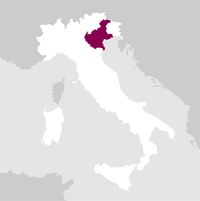Beschreibung
Bottega White Gold ist ein DOC-Wein aus Venetien, der aus der Vinifizierung von Glera-, Chardonnay- und Pinot-Trauben gewonnen wird. Es handelt sich um einen charaktervollen, frischen und eleganten Brut-Schaumwein, der das Herkunftsgebiet der Trauben zwischen den Provinzen Treviso und Venedig widerspiegelt.
Auszeichnungen
Details

Perlage

Parfüm

Farbe

Geschmack
Servieren bei:
06 - 08 °C.
Langlebigkeit:
03 – 05 Jahre

Kombinationen
- Gründungsjahr: 1977
- Oenologe: Fabrizio Dorigo
Das Engagement von Bottega für Nachhaltigkeit ist ebenfalls von größter Bedeutung: Das Unternehmen recycelt silikonisiertes Papier, verwendet mindestens 85 % recycelte Glasflaschen, wählt Farben auf Wasserbasis für metallisierte Flaschen, befolgt die Kriterien des ökologischen Landbaus in seinen Weinbergen und verwendet recyceltes Plastik aus dem Meer. Darüber hinaus verwendet das Unternehmen ausschließlich 100 % erneuerbare Energie. Mehr lesen


| Name | Bottega White Gold Venezia |
|---|---|
| Typ | Weißwein naturnah schaumwein tankgärverfahren brut |
| Weinbezeichnung | Venezia DOC |
| Größe | 0,75 l |
| Alkoholgehalt | 11.0% nach Volumen |
| Rebsorten | Chardonnay, Glera, Pinot Bianco, Pinot Grigio, Pinot Meunier, Pinot Nero |
| Land | Italien |
| Region | Venetien |
| Anbieter | Bottega |
| Herkunft | Das DOC-Gebiet Venezia erstreckt sich von den Ausläufern der Provinz Treviso bis zum Adriatischen Meer (Provinz Venedig), d.h. von den Hügeln von Conegliano bis zur Lagune von Caorle |
| Klima | Dank des Schutzes, den die nahe gelegenen Dolomiten im Norden bieten, und der Nähe zum Meer und zu den Lagunen herrscht hier ein "feucht-gemäßigtes" . |
| Bodenzusammensetzung | Die Böden bestehen aus Schwemmmaterial, das durch das Abschmelzen der alpinen und voralpinen Gletscher entstanden ist und von den Flüssen Piave und Livenza transportiert wurde. Das Gebiet der Hochebene weist eine hohe Konzentration von Kieselsteinen und Schotter auf, die den Boden leicht, entwässernd und nicht zu fruchtbar machen, optimale Eigenschaften für den Weinbau. In diesen Gebieten werden die hochwertigen Trauben angebaut, die diesem Schaumwein Leben einhauchen. |
| Anbausystem | Sylvoz |
| Pflanzen pro Hektar | 2500 - 3000 |
| Ertrag pro Hektar | 140 q. |
| Ernte | Die Trauben der drei Rebsorten, aus denen der Verschnitt besteht, werden im Allgemeinen Mitte September geerntet. Die Trauben werden schnell in den Weinkeller gebracht, um ihre Qualität zu bewahren und Veränderungen zu vermeiden, die durch mechanische Beschädigung, frühzeitige Oxidation, mikrobielle Verunreinigung und Sonneneinstrahlung verursacht werden könnten. |
| Weinbereitung | Es folgt das Abbeeren, das sanfte Pressen der Trauben, um die Schalen vom Most zu trennen, und schließlich das Dekantieren oder Reinigen des Mostes. Etwa 5 % der Ausgangs-Cuvée werden 6 Monate lang im Barrique ausgebaut. Die für diesen Wein verwendeten Barriques bestehen zum Teil aus mittelstark getoasteter französischer Eiche und zum Teil aus leicht getoastetem Akazienholz. Französische Eiche ist ein Holz, das dem Wein Eleganz verleiht und edle Tannine hervorbringt, während Akazienholz Süße und weniger aggressive Tannine verleiht, mit einem Bouquet, das an Honig und Vanille erinnert. Die erste Gärung findet in Stahltanks statt, danach werden ausgewählte Hefen zugesetzt. |
| Reifung | Die zweite Gärung erfolgt nach der Martinotti-Methode in einem Autoklav, einem speziellen Druckbehälter aus Stahl, der eine genaue Kontrolle von Druck und Temperatur ermöglicht und auf 14 °C gehalten wird, um den typischen Duft und die Aromen der ursprünglichen Trauben zu erhalten. Bei der Umwandlung des Zuckers in Alkohol setzen die Hefen auf natürliche Weise Kohlendioxid frei, das sich im Wein auflöst und ihn schäumend" macht. Am Ende der Schaumweinbereitung wird der Wein kalt stabilisiert, gefiltert und in Flaschen abgefüllt. |
| Allergene | Enthält Sulfite |






